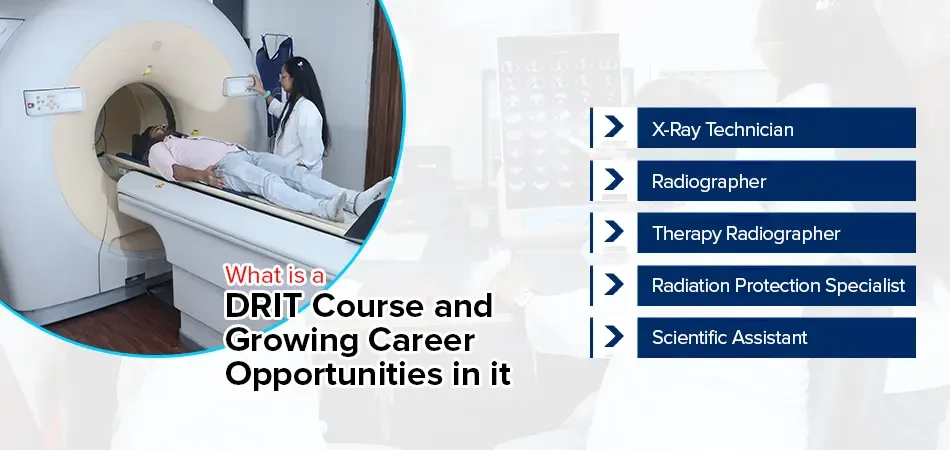What is a DRIT Course and Growing Career Opportunities in it?

DRIT :This course skills you with the best of practical knowledge. In this course classroom lectures and deliberations, the course involves supervised practical training. The students are skilled in various techniques and procedures of diagnostic imaging. This may involve the use of X-rays or other methods. The students are trained to create accurate and high-quality images through advanced Imaging equipment like ultrasonography (ultrasound or U.S.G), magnetic resonance imaging (M.R.I), and computed Tomography (C.T. Scan).
Eligibility Criteria:
- Candidates must have passed Class 12th in Physics Chemistry Biology/Maths (from any recognized Board).
- Few Universities and Institutions also conduct entrance examinations.
- One should hold a minimum 50% marks in 12th.
Syllabus:
| First Year | Second Year |
| Human Anatomy, Physiology and Pathology | Radiation Physics- II |
| Radiation Physics- I | Clinical Radiography- I |
| Radiography- I | Clinical Radiography- II |
| Basics of Computer |
READING MATERIAL:
Text Books to be Read:
- Radiographic latent image processing – W. E. J Mckinney
- Radiographic Imaging - Derrick
- Physics and photography principles of Medical Radiography – Seeman and Herman.
- Care of the patient in diagnostic Radiography – Chesney & Chesney.
- First Aid – Haugher and Gardner.
- Practical Nursing and First Aid – Ross and Wilson.
Job Opportunities:
- X-Ray Technician:These professionals provide Medical support. professionals who specialise in operating x-ray equipment and maintaining them.
- Radiographer: The healthcare professional who creates images for medical purposes with the help of special scanning machines.
- Therapy Radiographer: These are specialised in using radiography equipment to administer treatment. They control appropriate radiation doses to destroy cancer cells and diseased tissue while avoiding radiation of healthy tissue.
- Radiation Protection Specialist: These are specialised and focus on monitoring radiological emissions and exposure and controls the rays coming out of machines.
- Scientific Assistant:One can go for further studies and become a scientific assistant and also go with the research sector for more research and experiments for the welfare of the society.
Some of the job opportunities and annual average salary are as follows.
These are not the only job opportunities you can go with various governmental and private hospitals, Diagnostic centres etc. You can also join private healthcare companies as they also provide attractive salaries like- Access Healthcare, Apollo Hospitals, Elevance Health, Fortis Healthcare, Omega Healthcare etc.
| Job Opportunities | Approx. Salary |
| X-Ray Technician | INR 2 LPA |
| Radiographer | INR 2.7 LPA |
| Therapy Radiographer | INR 3 LPA |
| Radiation Protection Specialist | INR 1.7 LPA |
| Scientific Assistant | INR 3.3 LPA |
Introduction to some of Advanced machine these Advance machines:
MRI Machines: Magnetic resonance imaging machines are large, tube-shaped magnets. Where a patient lies inside an MRI machine, the magnetic field inside works with radio waves and hydrogen atoms in the patient's body to create cross-sectional images.
CT Scan Machine:computerised tomography scan is used to visualise all parts of the body and is used to diagnose disease or injury as well as to plan medical, surgical or radiation treatment.
PET Scan Machine: Positron Emission Tomography is most often injected into a vein within a patient's hand or arm. The tracer collects into areas of your body with the help of imaging techniques that use radioactive substances that have higher levels of metabolic or biochemical activity.
X-Ray Machine: These machines are used to create images of internal parts of the body like bones and muscles.
Frequently asked questions
Q1. What is the eligibility criteria of the DRIT course?
To pursue DRIT course one should have completed his 12th in physics, chemistry,Biology or Maths.
Q2. Can I join the DRIT course after completing 12th in Maths?
you can join the DRIT course after completing 12th in Maths. Criteria may differ in some of the institutions or Universities.
Q3. What are the fees of the DRIT course?
The fees of a DRIT course may vary depending on institution in government and non government institute. Average fees of a DRIT course is 80,000 Rs.
Q4. Can I do bachelor's after this course?
Yes, after completing a diploma course in DRIT one goes for bachelors if he wants to study further.
Q5. What is the duration of the DRIT course?
The duration of the DRIT course is 2 years as it is a diploma course.
Q6. What are job opportunities after the DRIT course?
There are many job opportunity after DRIT course in government and non government sector. Some of the opportunities are X-Ray Technician,Radiographer, Therapy Radiographer, Scientific Assistant etc. and many more.
Q7. What type of course is DRIT?
DRIT stands for Diploma in Radiology and Imaging Technology. It is a 2 year Diploma course.
Q8. What is the full form of the DRIT course?
The full form of the DRIT course is Diploma in Radiology and Imaging Technology.

